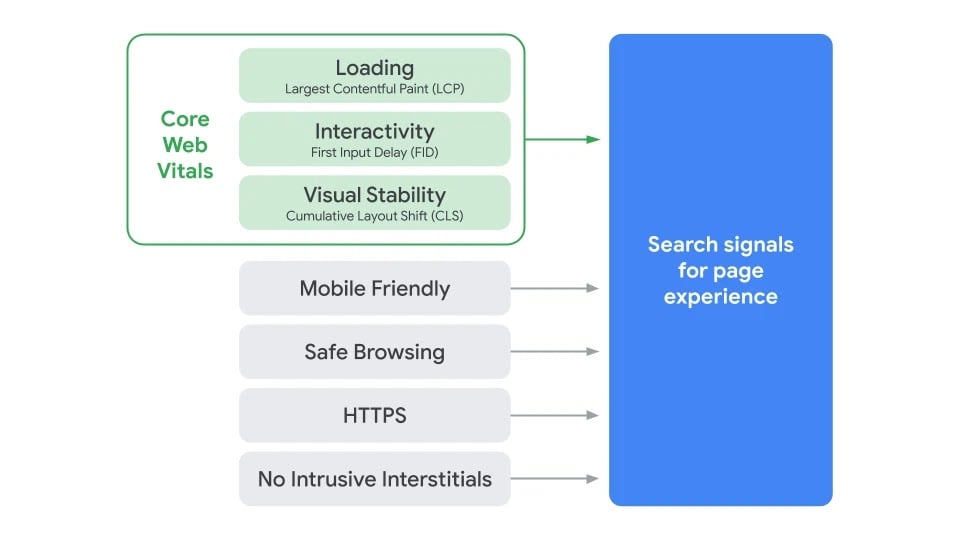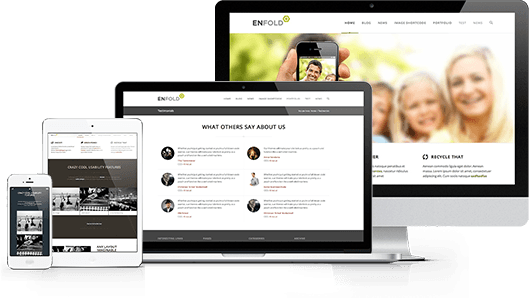Google Ranking factors: what is going to change in 2021?
About a month ago, WordPress Tavern published a rather disturbing article about a number of new Google ranking factors in 2021. The article states that as of May 2021 Google will rank websites more strongly based on user experience factors by means of ‘Core Web Vital statistics’. This includes factors such as page speed, responsiveness and the stability of content during loading.
The upcoming Google update combines these factors with previously announced UX-related signals for mobile friendliness, safe browsing, HTTPS security and intrusive interstitials (intermediate pages or web elements that appear before or on the mobile web page you actually want to visit, for example ads, banners or pop-ups).
Google has promised that website owners will have until May 2021 to improve their website metrics in terms of user friendliness, speed and structure. Since then, the company has seen a 70% increase of Lighthouse, PageSpeed Insights and Search Console’s Core Web Vitals report users in preparation for the update.
But what will be the effect of these new ranking factors on the current ranking system? That is of course the big question and nobody knows exactly. What we do know is that Google has promised to still give priority to pages with the best information in general. Hence, the website metrics related to user experiences, which will be used from May 2021, help a website to score better when there is a lot of competition on similar content.
Most likely this means that already existing Google ranking factors such as backlinks and content will remain important. So we think there is no reason to worry that the entire ranking system will be blown over by the Google update. Below we have made a list with which Google ranking factors will all remain relevant in 2021, taking the new update into account.
Type Google ranking factors
Before we present our top 6 Google ranking factors, with which you can optimize your website, we will first discuss the three different types of Google ranking factors. Marketers usually talk in terms of ‘on- and off-page’ Google ranking factors, but there are actually three distinct types:
Off-page ranking factors: external ranking factors that are not measured on your website by Google and mainly relate to backlinks.
On-page ranking factors: ranking factors that are measured on your website itself and are related to the keywords and informative quality of your pages.
Technical ranking factors: factors that are also measured on your website itself, but have more to do with the overall performance of the website as a whole, as opposed to individual pages as is the case with on-page ranking factors.
It is important to note that there is not a single Google ranking factor that will make or break your SEO. It is the sum of all your technical, on-page and off-page efforts that will determine your website ranking.
The 6 major Google ranking factors in 2021
Now that we have categorized the Google ranking factors, we are pleased to present the 6 important ranking factors in 2021, starting with the technical ones.
1. Core web vitals
As discussed in the introduction, Core Web Vitals are the latest user experience metrics that will soon become very important Google ranking factors. The statistics measure the first impression the user gets when visiting a website. For now this impression will be made measurable with three metrics, but there will most likely be more in the future. These three measurement factors are the loading time, interactivity and stability of a website.
Google has released a detailed set of guidelines to optimize every vital website part. In summary: for faster loading, Google recommends better service response times, less JavaScript and CSS blocking and faster loading of resources. For improved interactivity, Google recommends splitting codes and using less JavaScript.
Finally, for improved visual stability, Google recommends using size related guidelines for images and videos. This content should also be loaded from above so that images and videos are visible immediately. For more in depth knowledge about the Core Web Vitals we recommend reading the following article.
Want to know how to measure core web vitals on your own website? Then read the following article.
2. Mobile optimization
Since September 2020 Google uses mobile-first indexing when crawling websites. This means that Google’s search engine mainly uses the mobile version of a website for evaluating a page.
Even if the desktop version of your website is fully optimized, your ranking in Google’s search engine can take a huge hit if the site is not optimized for mobile traffic. So always preview your web pages on the mobile to see if they are easily accessible on this device.
You can use this test of Google to check whether your website is mobile friendly. If your website is sufficient, you’ll get a green light and if not, you’ll get (some) suggestions for improvement.
Checking your website page by page may be a bit impractical. You can also choose to use the Google Search Console tool to check all your pages at once. Instructions: Start the tool, go to Enhancements > Mobile Usability and view a report compiled with a list of suggested improvements.
In this article on Mobile SEO you can read more about how to optimize your website for mobile traffic.
3. Internal links
As mentioned in the article about Mobile SEO, search engines crawl different types of content and index them accordingly. The search engine uses internal links as a method to analyze information and index it correctly. In this context, the term ‘internal links’ refers to any hyperlink that refers to an internal page on a website.
In practice, this means that the more organized and thoughtful your internal link structure is, the easier it is for search engines (and users) to find what they are looking for.
To realize this, when creating a new page, you need to think about which pages you are going to link to. As we also have done in this article.
A popular method to structure internal links is by creating subject clusters. The idea is simple: you create content around a specific overarching topic and maintain interconnectedness within this cluster.
Furthermore, topic clusters are also beneficial from a user experience perspective. It makes content easy to navigate and readers will find that they do not have to go to multiple sites to find what they are looking for. This also increases the ‘average time on website’, which is also an important parameter for a better ranking.
4. Backlinks
On the contrary to an internal link, a backlink is a hyperlink that comes from a page outside your website. In 1996 Google launched its groundbreaking PageRank algorithm update that made the number and quality of links to a website or page a strong indicator of a website’s ranking. Ironically enough, this is still the case more than two decades later.
It seems that Google is planning to abandon backlinks in the future, but for now this still seems to be a pie in the sky. Backlinks are and will remain the most important ranking factor for a website for the time being. So your goal should be to get as many backlinks as possible from domains with a high authority.
There are several backlink strategies to grow your backlink profile. The three most important are writing quality content that peers in your sector can share, guest blogs and the most difficult one: cold-outreach. To get more ideas of what kind of backlinks are suitable for your niche, competitive research is very useful. Tools that can help you on your way are for example SE Ranking and Ubersuggest.
5. Relevant keywords
There is no doubt about whether relevant keywords are the basis for an effective SEO strategy. Keywords are the search terms that people use when they visit a search engine to find what they are looking for. Before you start creating content for your website, it is crucial that you do a keyword search.
It can be a challenge to find out which keywords to use, where to place them and how often to do this. In order to have as much chance as possible to rank well, it is a good strategy to benchmark the top pages of your competitors. You can do this with the tools SE Ranking and Ubersuggest, which in our opinion are two of the best SEO tools.
Once you’ve determined your keyword strategy, it’s time to create content. One tool that can be very useful for meeting SEO variables on the pages you are going to create is Yoast. Yoast gives you, among other things, an indication of how often you should use the keyword and where to place it. It also gives advice about the link structure on the pages you are going to design.
6. Quality content
In the good old SEO days it worked to stuff your pages with many different keywords at the same time. Nowadays focus is very important in SEO and a page has to meet an appropriate number of relevant keywords, titles and images in order to rank well. Hence, the page should be written in a ‘natural copywriting style’ with qualitative information as the main focus. After all, the goal of the visitor and Google is to get an answer to the question they have been looking for.
Most content loses its value over time. Articles you have written in 2018 become obsolete at some point and Google search trends change over time. So try to take a closer look at older pages and complement them with new keywords and information.
Some pages may need a complete rewrite, while others only need a few minor adjustments to bring them back to life. If you are updating a message, republish it with the new publication date. This will give your visitors the impression that the message is brand new. Don’t forget to delete the old message otherwise Google will see it as duplicate content.
Google’s algorithm keeps evolving
The new update of Google that will be implemented in May 2021 shows us to keep an eye on the ever evolving SEO landscape. It is highly likely that in the future current Google ranking factors, such as backlinks and keywords, will gradually lose their value. Other factors, such as user experience and qualitative content, will take their place.
At the same time, there is no such thing as an SEO miracle cure. Climbing into the search engine takes time. It turns out that Google’s algorithms are erratic and that updates can completely overhaul the current ranking system. The most important notion to keep in mind is therefore to keep your website as relevant and informative as possible for your visitors.
Google wants to show the most relevant search results for each search, so that everyone can find the information they are looking for as quickly as possible. So if you do your absolute best to show your visitors the most relevant information possible, Google will notice it and will reward you with a positive ranking.








